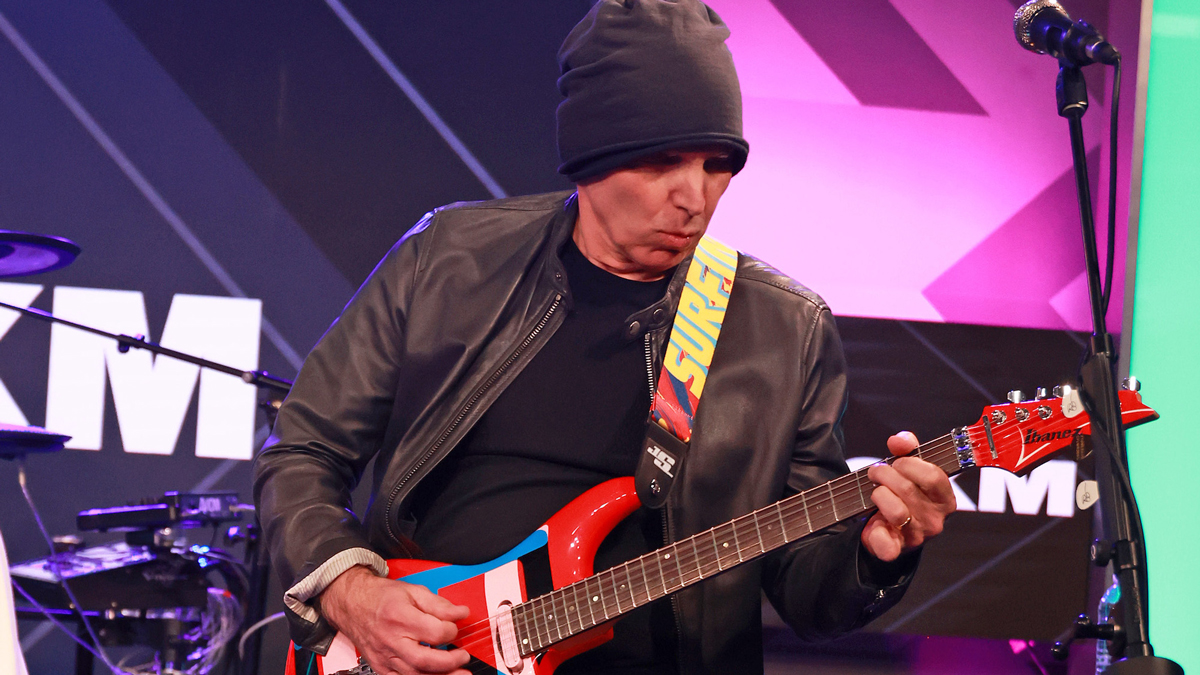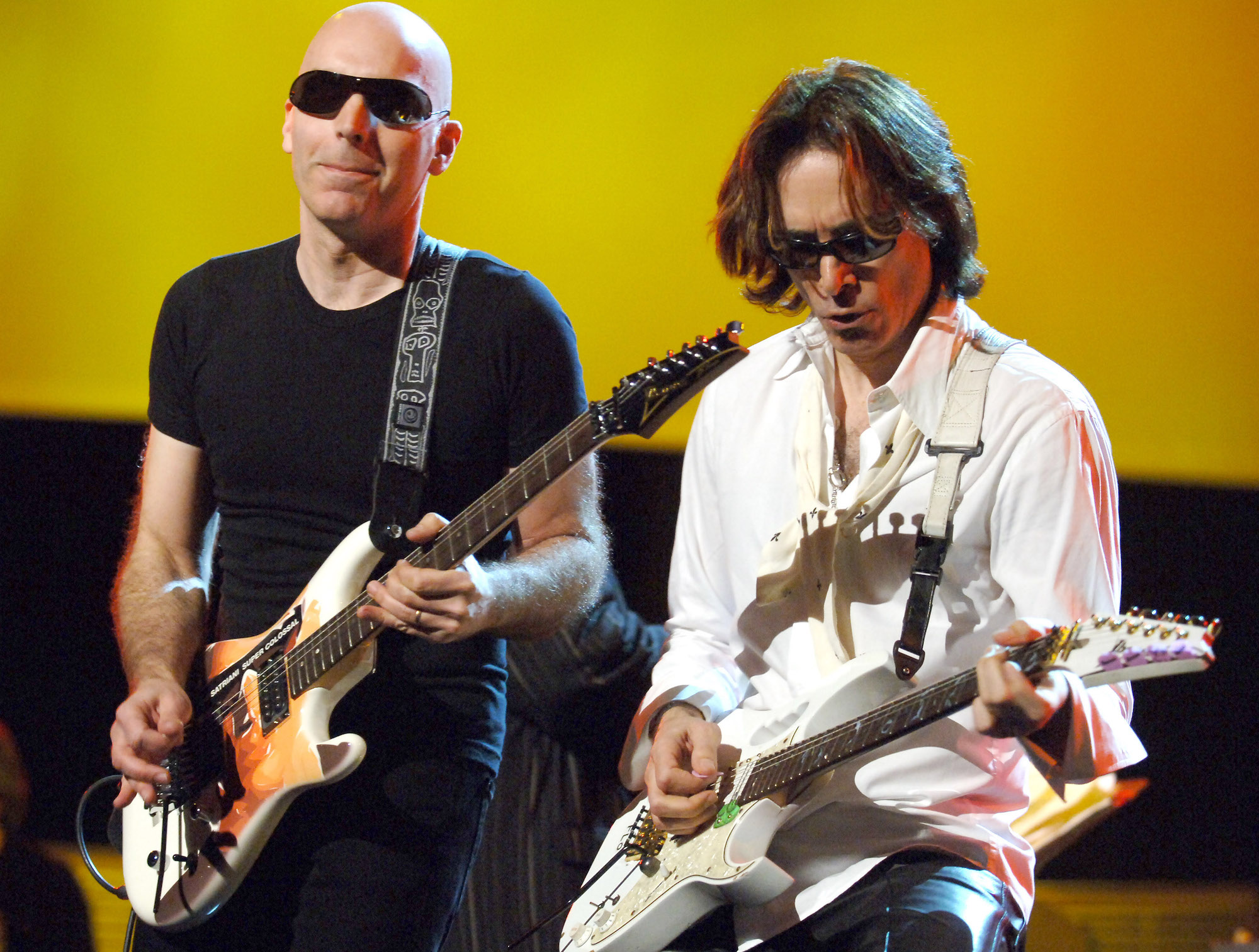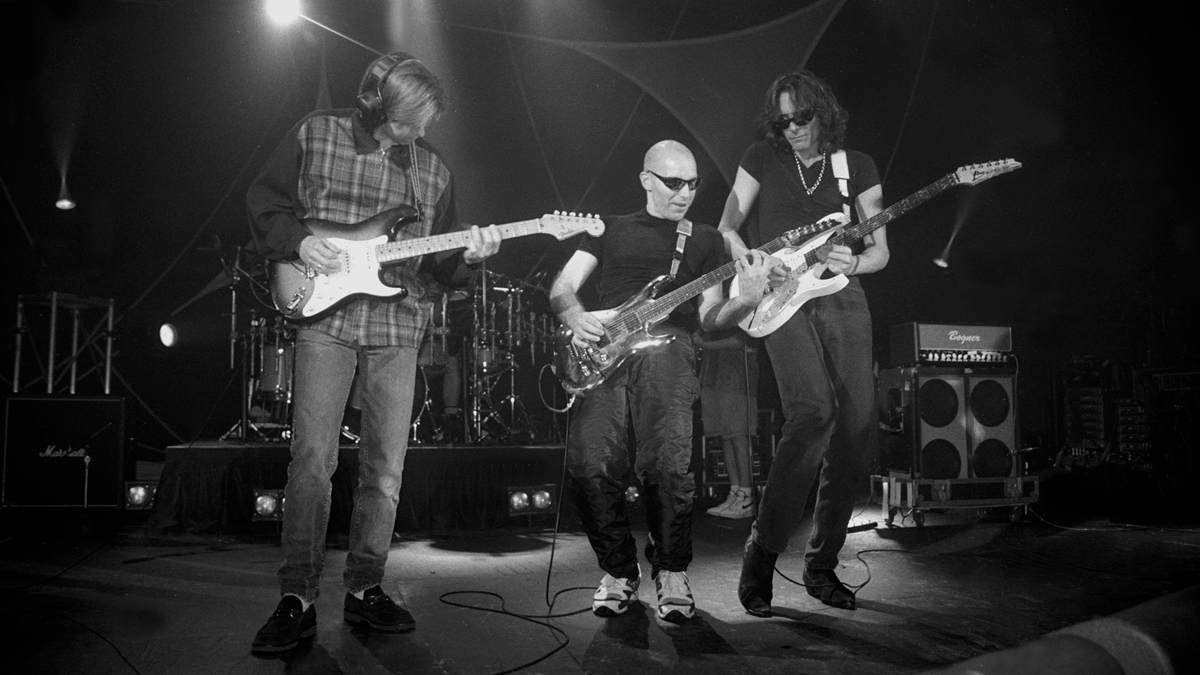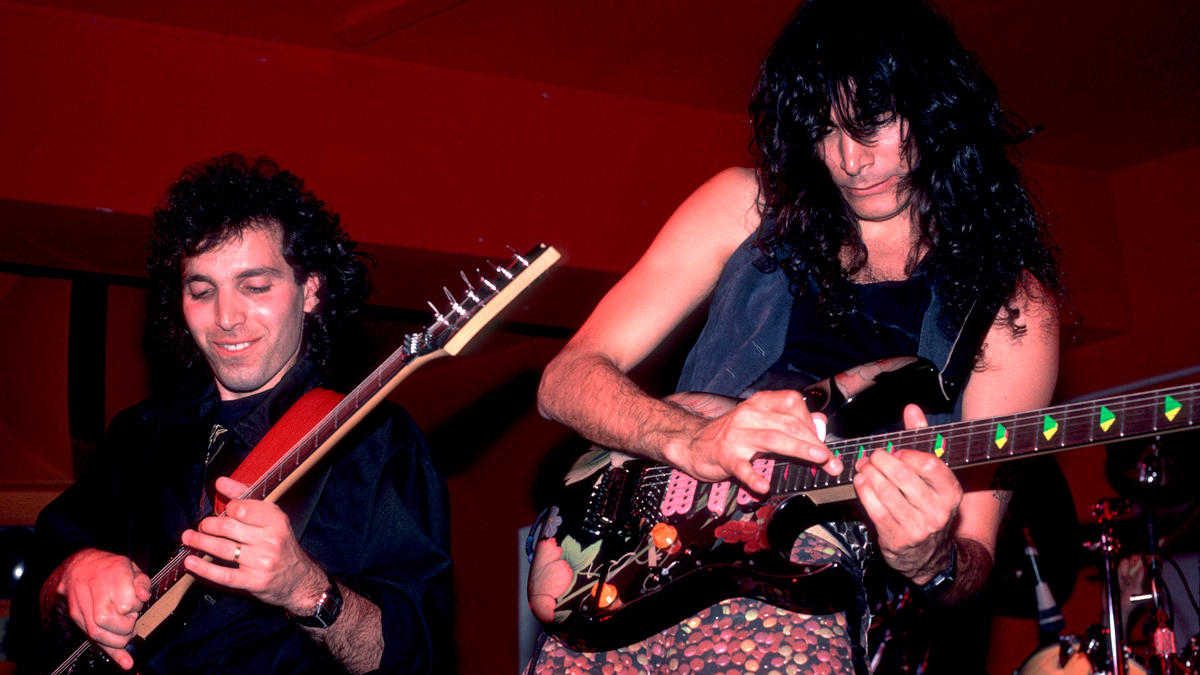
Joe Satriani is primed for world domination in 2024. An original G3 revival. A tour with Steve Vai. Not to mention a Van Halen-adjacent trek with Sammy Hagar, Michael Anthony, and Jason Bonham. It's pretty epic, even by Satriani's lofty standards.
For starters, The Best of All Worlds tour has Van Halen fans all but quivering with delight. And Satriani, while tired, is excited, too, telling Guitar World, “It's nice, but I'm still recovering. I've had such a crazy schedule leading up to going to L.A. to do Howard Stern and Eddie Trunk. But I'm looking forward to all the playing – it’s going to be fun.”
As for how he became entangled in the world of Van Halen once more – after rumors of a reunion-meets-tribute tour alongside Alex Van Halen and David Lee Roth fizzled – he says, “It was just this crazy idea that was presented to me when Sammy called while my hands were covered in paint.
“I was trying to finish some commissions for an art show, and Sammy called me saying, 'We're going to perform live,' and I was like, 'Are you kidding? I haven't even come close to learning any of this material.'”
As challenging as the licks are, Satch can out-shred most. And so, it's the mental aspect that will prove the toughest. “I have to get over arguing with myself that it doesn't sound right,” he says. “I'll have to go through some mental therapy and be okay with sounding a bit different [than Eddie Van Halen].
“I have several months to work on it,” he continues, “but also, I tried using .11s for the radio shows, which is what Vic Johnson does in The Circle, but they tangled up my fingers, and once we started playing, I said, 'These strings feel too fat for my fingers,' and it threw me off.
“So, we talked about it, and we think .9s will be part of the secret formula for the Eddie Van Halen sound. Without those, you don't get the expressiveness and the slinkiness. And I've got to figure out the string tension and the tuning. It’ll be a couple days of experimentation.”
But that's not all. Satch is going all-out in 2024, having called upon Eric Johnson and Steve Vai to reunite the original G3 lineup, bringing waves of watershed shred to the masses who have heard the stories but never witnessed those three legends sharing the stage.
Looking back on the reunion of the original G3, Satriani says, “It was this crazy idea, but it turned into a great success, so why not celebrate it? We’re reuniting the original guys, and we're talking about how we’ll arrange the show in a way that reflects the times. It's a labor of love, but at the same time, it's shared by us all.”
And, if that wasn't enough, Satch has somehow found enough energy to wedge a double-bill tour with his old friend – and longtime partner in shred – Steve Vai into his 2024 schedule.
“We realize that when we play together, it’s a place where we can do whatever we want with our partner in crime,” Satriani beams.
“So, we're intentionally excessive,” he laughs. “We just go crazy. We try to outdo anything we've done before and have fun. We're truly the best of instigators when we're around each other.”
Catching his breath before his biggest year yet, Joe Satriani dialed in with Guitar World to give the scoop on The Best of All Worlds tour, the revival of the OG G3, touring with Steve Vai, and the gear that will accompany him on all of these treks.

What's your mindset like preparing for The Best of All Worlds tour?
“It's daunting to suddenly think, 'How am I going to get this stuff under my fingers?' I explained this to Sammy by saying, 'Look, I can't start learning this stuff until I finish these paintings I’m commissioned for.' But afterward, I had a few days to review the ever-changing setlists thrown my way by Mike and Sammy, who were so enthusiastic and have been playing these songs forever.”
Was it difficult to play catch up?
“I kept saying, 'I've never played that one, or I don't know it yet,' and that's what I explained to Howard Stern. After being a super-fan of Van Halen when they first came out, I realized that if I learned how to play this stuff, it would seep into my playing. So, around ‘88, I consciously decided not to figure it out. I'd put it on and have a good time, but I never looked to figure out what Eddie was doing.
When Sammy got into Van Halen, the music got broader and wonderfully complicated in a harmonic sense. And, of course, there was no end to the technical innovation that Eddie brought to the fretboard
“And then, I got the call from Alex [Van Halen] and Dave [Lee Roth] a couple of years ago, and I realized, 'Wow, I don't know how to play any of it.’ I explained that to them, and maybe every three or four weeks, I'd call them up, saying, 'I'm not doing it. I'm sorry; I'm not your guy.' So many guys were good at it, but they would talk me back into it, saying, 'No, you're the guy.’”
But that was Roth-era stuff; now you're also looking at the Sammy era.
“Yes, and that's quite different from the music Van Halen was writing and putting out beforehand. Because when Sammy got into Van Halen, the music got broader and wonderfully complicated in a harmonic sense. And, of course, there was no end to the technical innovation that Eddie brought to the fretboard.
“It was very idiosyncratic, and if that wasn't part of your natural wheelhouse, it would be awkward to learn each little piece, and I'd go, 'How am I going to do that? It's not my thing,' you know? So, I made all the excuses, saying, 'Look, I'm gonna screw these up,' but it's all in good fun. I'll figure it out by the time the summer tour comes.”
Another critical component is Eddie’s rhythm playing. The solos are one thing, but how will you approach those intricate rhythms?
“The good thing about that is that the stuff has been around for a while and is well-documented. There are manuscripts and tablature to figure out the notes I can't pull from the records.
“But some of this stuff, like I'm the One, Eddie starts like 10 clicks faster than when the band kicks in, but somehow, they make it work. They had a relationship where there was a highly developed sense of rhythm and how they could play with time while still making everything sound fun.
“But if you go to play it, man, I've seen guys that play it well because they have similar skills, and that's what comes naturally to them as far as their wheelhouse. And so, the one thing that came over me when I got into this, which I explained to Dave and Alex, is I spent decades sitting way back in the pocket because I was playing melodies. To get melodies to work, you've got to sit back and let the band get things established to where the groove and rhythm guitars push.
“But suddenly, I've got to play these parts that Eddie wrote, where he was functioning differently. He was pushing with this incredible architecture of chord work, like in a song like 5150, where Sammy gets to sit back as he's doing the melody. So, the most awkward thing was suddenly not doing the melody and stepping in first on top of the beat. Eddie did that, but he never sounded like he was rushing.”
And lest we forget, you've got your own tone and style – which fans expect to hear, regardless of whether you're playing Eddie's parts. And yet, they’ll want it to sound like Eddie. How do you manage that?
“That’s a great question. After we finished going to those shows the other morning, the thing on my mind – besides the fact I royally screwed up, which hurt like a thorn in my side, but I'll get over it – is, 'This is a mental thing for me.' And that’s something I experienced when I played with Deep Purple; I went through the mental torture of playing Smoke on the Water and having my guitar not sound like Ritchie Blackmore's.
“This thing in my head kept going, 'It's not right. It should be a Strat into a Marshall.' But instead, there was a lot more gain, and I was using a [Boss] DS-1 [Distortion] in a 100-watt Marshall head, which is not Ritchie Blackmore. It affected how I played, even though I tried to sort myself out, saying, 'It doesn't matter; it's the notes and the phrasing,' but, as a fan, I wanted to hear the right sound.
“And as you've brought up, that's the case I find myself in here, where I want to honor the sound, but I don't want to lose myself in somebody else's sound. Funnily enough, I was trading texts with Sam and Mike last night, and I had one question: 'Hey guys, what was the most successful live rig Eddie used, in your opinion?' They spent years touring with Eddie and watching him try all kinds of stuff, so I was curious.”
And what was the consensus?
“It's tough because I watched [concert video] Live Without a Net and thought, 'Oh, that's cool.' Eddie has Marshalls, Eventides, power amps, and all this stuff, and there's a certain appeal to it. It wasn't as grainy, and chorused. You can see how he got into new gear at one point, but one song sounds better with the old gear, while some sound better with the new. I'm sure Eddie struggled with that as he tried to innovate.
“But the difference between Live Without a Net, Live: Right Here, Right Now from '93 and then Tokyo Dome Live in Concert from '15 is remarkable. It's like this different idea of what a guitar should sound like. During the Tokyo shows, Eddie has more gain than you could ever want, and it's more compressed, which made sense because of the gain structure of the [EVH] 5150 III.
“I have total respect for how Eddie moved into that. He probably struggled with it the most because I'm sure when he sat down to do the beginning of Mean Street, he experienced what I did on Howard Stern, where it's like, 'There's too much gain,' because you want a peak in the midrange of the gain so you can get those harmonics to sing out as loud. But if you cross the line, you get too much surface noise. But to try and figure all of that out at six in the morning was like, 'Damn, this is rough.'”
Is the gear we saw during the Howard Stern performance what we can expect going forward?
My rig doesn't work because my live rig is designed so that I can play above the 12th fret on the first strings and still have everything sound fat. I realized there's no way to play the Van Halen stuff on my rig – it's a different animal
“I was using a Fender Tone Master Pro because I couldn't figure it out. My rig doesn't work because my live rig is designed so that I can play above the 12th fret on the first strings and still have everything sound fat. I realized there's no way to play the Van Halen stuff on my rig; it's a different animal. But I do have two 5150 III amps, which are tough to use at low volume, so I settled on the Tone Master Pro, and I came across a 5150 III model and said, 'That sounds great, it's just like a real amp.’
“But then, you go to play something on the treble strings and say, 'Oh, what happened?' because it sounds like somebody took the fat gain knob and turned it down six numbers. I don't know what it is; I don't know what the deal is with modeling and why they can't get that quite right with high-gain stuff. But anyway, I had to use something at low volume because it was radio station stuff, so we were all in a digital space together, where I just had to aim for the middle.”
What songs are you most excited to tackle?
“I'm looking forward to playing songs like The Seventh Seal where Eddie had a huge, cinematic approach to the compositions. There are some great grooves, and then there's the gorgeous guitar sounds, and when you play them, like when playing 5150, you look at your fingers and say, 'Man, this is beautiful.'
“It's one thing to listen, but when you play them, you go, 'This is so much fun; it's no wonder Eddie had so much fun playing this.' What Eddie accomplished with all-encompassing rhythm and melodic guitar parts is just so great. So, I look forward to that. And, of course, I want to do Panama and Ain't Talkin' 'Bout Love, too.”

You've also revived the original G3. What led to the return of the inaugural lineup?
“That was a real turning point for me. I'm so excited that Eric and Steve were up for it. It came out of left-field when we first did it, but when we sat down to mastermind the tour, we went from 12 players to seven and said, 'There's no way to get out of a venue before curfew this way.' So, we reduced it and settled on the three of us.
“Not only was three a cool number, but it was also manageable and would give us all at least 45 minutes to do what we wanted. That was the key element to enticing other players to come and play: they had to feel they would have enough space before jumping up and jamming.
“And now, my son is making a documentary about the whole thing, which is cool because the original G3 is when I first took him on tour. That's the first time he saw what his dad did when he walked out the door [laughs]. I also look forward to seeing how it turns out from his viewpoint.”
And incredibly, you've also found time to fit in a tour with Steve Vai.
These are two exciting songs, and the theme is very close to our hearts in a personal way
“Steve and I have known each other since we were kids. And we've not only known one another, but we've also been playing guitar for the same amount of time. It's natural for us to want to play our guitars together, dating back to our days growing up in Carle Place [Long Island], and we certainly don't rein in our mayhem when we see each other [laughs].
There's some new music in the works, right?
“We're interested in what each other is trying to do. It can be a big project, or something we've just thought of that we're hearing the first couple of seconds of. It's wonderful to hang out with Steve, and I spoke with him just yesterday for a bit. We'll be working on two songs, but he hasn't heard them yet. But I was trying to explain what I’d written to him, which is this theme of us returning to a place where we'd hang out in our cars where we grew up.
“So, we'll work on the tracks, but since we're both traveling, we won't be able to get in the studio together for a traditional session. We’ll have to do these tracks remotely and on the fly, which is fine because it’s not unusual to have tracks put together by recording in hotel rooms, and then assemble them later. But these are two exciting songs, and the theme is very close to our hearts in a personal way.”

With all you've got happening, you must be flush with gear. Is any of that new tech primed to find its way into your many projects?
“It's been so crazy with this thing the last few years with Alex, Dave, and now Mike, Sam, and Jason. So, there's been so much gear coming into my studio and going out just as fast [laughs]. Luckily, I'm very comfortable with my signature Marshall heads [JVM410HJS], the main thing that's made me happy. I can always go back to them and make anything from my catalog sound good with them. Whenever I get an invitation to do something new, I realize how personalized my sound and setup are.”
How do you work around that?
I've got like 20 Fender amps, and I try every new amp that comes in. And the amp that has stayed in my collection the longest is the new ‘68 Fender Custom, which really was a success
“Well, that's why I've got like 20 Fender amps, and I try every new amp that comes in. And the amp that has stayed in my collection the longest is the new ‘68 Fender Custom, which really was a success. I love the sound, and they're useful in the studio; it's insane when you think about how much great music has been done on Fender Champs and Deluxes.
“But I do like the 5150 line. I liked the original 5150s a lot, and I used it on the Chickenfoot albums. And the new 5150 IIIs are insane, even though I don't play the kind of music they're geared for. But when I make believe that I can play that music, I go, 'Man, this is a great amp.'
“But I think all guitar players are scratching their heads over analog versus digital. That's the biggest thing on a practical level. We're all trying to figure out how to fly around the world and cut down on weight and size. But there are still plenty of gigs where you plug into an amp.
“I'm not doing endorsement deals now, but I'm sure there is someone who has the head and the stamina for the retail world to have it all make sense for those of us who get a call at six in the morning to play The Howard Stern Show and do their best impression of the greatest guitar player of all time.”
- The original G3 lineup reunites in January 2024, while the Satch/Vai tour starts in March – see Satriani.com for full dates. The Best of All Worlds tour kicks off in July 2024 – RedRocker.com has full listings.







